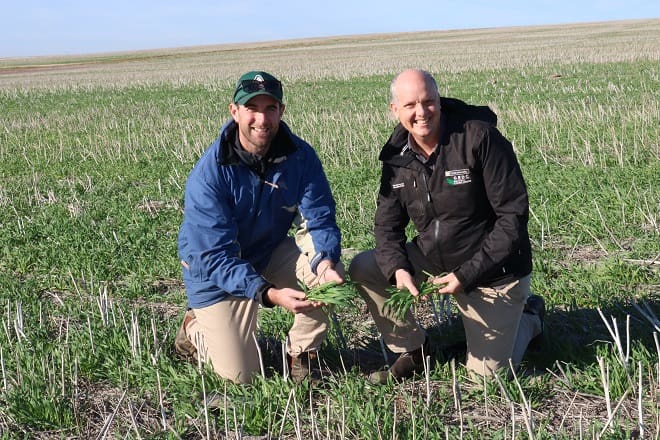
Nutrien agronomist Kyran Brooks and CCDM director Mark Gibberd.
FIRST-YEAR results from a unique project have confirmed fungicide resistance to both spot and net forms of net blotch in barley is widespread in southern areas of Western Australia’s grainbelt, with findings of reduced sensitivity or fungicide resistance the dominant situation.
The results are from the Barley Disease Cohort Project, involving innovative collaboration between researchers and WA barley growers, which is helping to find new in-field and locally relevant solutions to the growing issue of fungicide resistance.
The three-year pilot project, now in its second year, is being conducted by the Centre for Crop and Disease Management (CCDM), a leading Australian research centre with co-investment by the Grains Research and Development Corporation (GRDC) and Curtin University.
The project involves growers as collaborators in important fungicide resistance research.
“A cohort of 173 barley growers from WA’s southern grainbelt participated in the project during the 2019 season,” CCDM director, Mark Gibberd, said.
“They helped to provide a clearer picture of the spread and impact of fungicide resistance in their region and worked alongside our research team to mount a local response to this growing issue.”
Samples of 330 diseased barley leaves provided by the grower cohort for analysis in 2019 were from paddocks across the WA grainbelt, spreading from Cadoux in the north to Boyup Brook in the south-west and Boyatup in the far eastern area of the Esperance port zone.
Two diseases
The project focuses on the two barley diseases – spot and net forms of net blotch – as they are caused by pathogens with detected resistance to Demethylase Inhibitor (DMI) fungicides in the region.
Using innovative and high-throughput laboratory-based technologies, CCDM researchers carried out 2250 disease and fungicide resistance diagnostic tests on the cohort’s samples.
This work is continuing in 2020, when the centre will invite the growers to submit more paddock samples to help refine the 2019 results, and again provide feedback on the performance of their crops towards the end of the season. Several large-scale field trials comparing current management with alternative management techniques are also underway this year.
The centre will also contact cohort members to discuss their disease management strategies and continue to test fungicide resistance management techniques in-field, with the ultimate goal of providing growers with locally relevant options for managing fungicide resistance.
Resistance threat
Professor Gibberd said the 2019 results highlighted both the threat of fungicide resistance and the benefits of a collaborative and local approach to research.
“Fungicide resistance is an issue that evolves over time and is borne out of a pathogen’s ability to adapt, so local knowledge is vital for developing effective management strategies against it,” he said.
“As fungicide resistance increases, industry demand for in-field techniques to manage the problem is growing.
“Strong co-investment is supporting our centre to tackle this worldwide issue from a local perspective – we are working closely with growers to share information and improve fungicide resistance management in their region.”
The CCDM has worked on fungicide resistant pathogens for many years, discovering cases across Australia, establishing cutting-edge techniques in the laboratory and in the field for detecting mutations in the fungus, and communicating this information to the Australian grains industry.
Fran Lopez-Ruiz, who leads the CCDM’s Fungicide Resistance Management and Disease Impacts research theme, said the ‘co-innovation approach’ used in the Barley Disease Cohort Project was providing invaluable information to researchers.
“Information from the project has helped us uncover new mechanisms of fungicide resistance – and for net blotch these are much more complex than initially thought,” Dr Lopez-Ruiz said.
“The samples from growers provide an ideal resource to underpin many of the more technical discoveries that will enable more effective detection, screening and management of fungicide resistance.”
Extending chemical viability
An important part of the centre’s work is protecting the limited chemicals still effective for managing crop disease.
“Results from the Barley Disease Cohort Project’s first year are concerning because they confirm the potential for the loss of some DMI fungicides is very widespread across the sampled area,” Dr Lopez-Ruiz said.
Of the 330 barley samples tested in the Barley Disease Cohort Project in 2019:
153 (46 per cent) tested positive for the presence of both diseases spot form net blotch (SFNB) and net form net blotch (NFNB), 165 (50%) were positive for the presence of SFNB only, and four (1%) for NFNB only. Eight (2%) had no SFNB or NFNB present.
51 (15pc) carried the CYP51A F489L mutation, which is associated with various levels of fungicide resistance in both SFNB and NFNB.
Only 21 samples from the 450+ millimetre rainfall zone were categorised as sensitive. A high number of samples (161) had reduced sensitivity and 28 of the samples were fungicide resistant.
Definitions of fungicide resistance:
A sensitive result means the fungicide should still work reasonably well.
A reduced sensitivity result means the fungicide may still work reasonably well at controlling the target pathogen, but not as well as it would on a sensitive population. You still have management options, however, reduced sensitivity populations are also at greater risk of becoming fungicide resistant if you continue to use these actives.
A fungicide resistant result means the fungicide is not likely to control these pathogen populations, and therefore should be avoided.
Source: GRDC



HAVE YOUR SAY